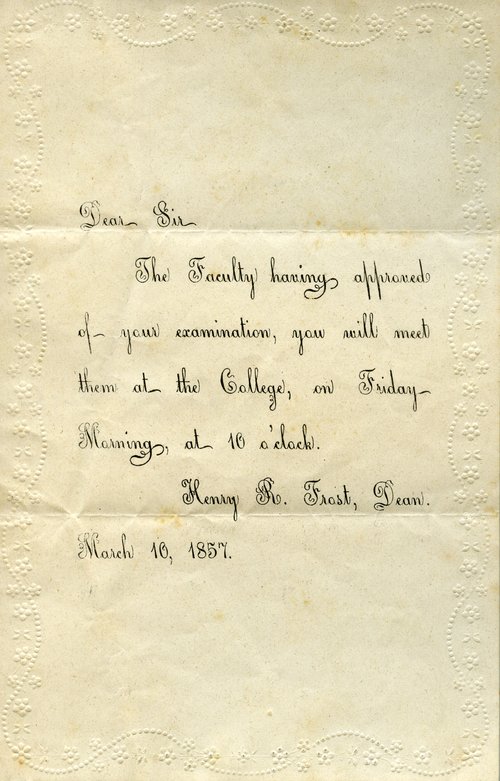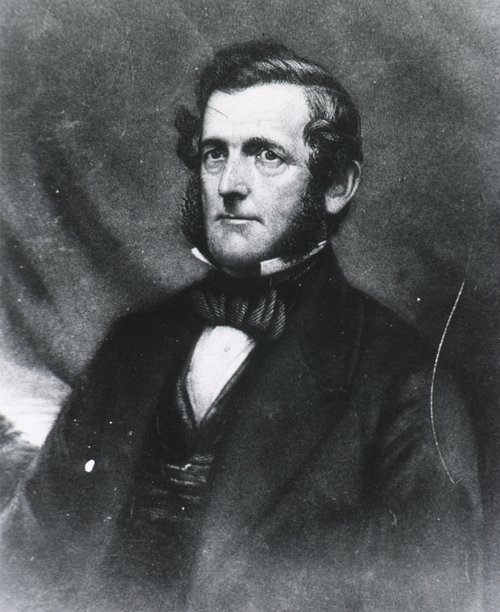“Of Good Moral Character:” The First Students of the Medical College
<br/>
<br/>

That inaugural academic year began on Monday, November 8, 1824 and ended at the end of March 1825. Just as the Medical Society intended, the college did indeed attract a number of Southern students from South Carolina and Georgia who had begun their educations at Northern medical schools. While their classmates enrolled to complete two years of coursework, the first five graduates in April 1824 each had the necessary credentials in hand to enroll for only one academic year. The faculty expected students to be “of good Moral Character,” and at least twenty-one years old by the time of their dissertation defense. At the end of the school year, each student’s “general deportment” was reviewed by the faculty and Medical Society.
<br/>
In order to receive their M.D., students were required to attend two years of coursework in each subject offered by the faculty, unless they could prove they had previously enrolled in coursework at another medical school. In addition, they were expected to complete what was essentially a three-year residency with “some respectable practitioner,” often at the Marine Hospital or the Almshouse, in order to gain hands-on experience with patients. With coursework complete, students could submit written dissertations to the dean for review. The candidates whose dissertations were deemed satisfactory were invited to a first round, private defense before the entire faculty of the Medical College and an honorary board. Upon passing that, the candidate was then invited to a second, public defense of their dissertation topic before the entire Medical Society of South Carolina on April 2nd, at which time the society would vote on his “fitness” for degree. For those students who passed, they were invited to attend a public graduation ceremony hosted by the Medical Society, where candidates received their diplomas in front of “the Literary and Professional Gentlemen” of Charleston.
<br/>
(Image description: Handwritten letter written by Henry Frost on March 10, 1857.
Waring Historical Library, Manuscript Collection, MSS 18.)
<br/>
<br/>
The First Graduates
<br/>
Commencement was held at College Hall, the temporary school building in the Marine Hospital yard, at noon on April 4, 1825. There, the faculty and members of the Medical Society of South Carolina presented diplomas to its first graduating class, made up of the following five students:

<br/>
<b>Jon L. Felder</b>
, of Sumter District, South Carolina, had been enrolled at the University of Pennsylvania during the 1823-1824 academic year before transferring to the Medical College of South Carolina. He was about twenty-two years old when he presented his twenty-three-page
dissertation on gunshot wounds
. He returned to Sumter following graduation, where he appears in the 1850 census as a physician. He died sometime before 1870.
<br/>
<b>Ignatius Poultney Garvin</b>
, of Augusta, Georgia, was the youngest graduate, about twenty years old, when he submitted his fifteen-page
dissertation on cholera in infants and young children
that presented during the summer. He had begun his medical education at the University of Pennsylvania before enrolling at the Medical College of South Carolina. After graduation, he returned to Georgia, establishing a medical practice at Waynesboro before being appointed to the board of trustees of the Medical Academy of Georgia in 1828. He joined its faculty in 1839 as professor of Materia Medica. He died on May 26, 1880, and is buried at Magnolia Cemetery in Augusta.
<br/>
<b>Charles W. Grayson</b>
’s sixteen-page
dissertation addressed “Country Fever”
as it presented in and around his hometown of Beaufort during the summer and fall. It is unknown which medical school he had attended prior to completing his studies at the Medical College of South Carolina. Grayson died two years after graduation in July 1827. His death was attributed to a particularly violent case of bilious fever, the very malady he studied for his dissertation. He was twenty-three years old.
<br/>
<b>William G. Webb</b>
of Charleston presented a seventeen-page
dissertation on “worm fever,”
which addressed the symptoms, including presentation in at least one enslaved baby, and a variety of treatments for worms in young children. Prior to enrollment at the Medical College of South Carolina, he had attended the University of Pennsylvania from 1822 to 1824. Little is known about Webb after graduation, however he appears in the 1850 census as a physician practicing in Barnwell, South Carolina.

<br/>
Of the five men to graduate in 1825,
Eli Geddings
was the most famous. Born in the Newberry District in 1799, he attended the Abbeville Academy and had attended lectures at the University of Pennsylvania prior to enrollment at the Medical College in 1824. Already licensed and having practiced, Geddings served as a demonstrator in the anatomical room while enrolled as a student. His dissertation was on blood circulation. He completed further training abroad in Paris and London before returning to Charleston in 1827. Geddings continued as a demonstrator at the Medical College before accepting an appointment at the University of Maryland in 1831. He eventually joined the faculty at the Medical College of the State of South Carolina as Professor of Pathological Anatomy and Medical Jurisprudence, a position created specifically for him, in 1837. He remained on faculty until 1873 and continued in a visiting capacity until his death on October 9, 1878. Geddings is buried at Magnolia Cemetery in Charleston.
<br/>
(Image Description [1]: Handwritten minutes from the meeting of the Medical Society on April 6, 1825. Waring Historical Library, Medical Society of South Carolina Digital Collection,
Medical Society of South Carolina Meeting Minutes: 1810-1833.
)
<br/>
(Image Description [2]: Black and white portrait of Eli Geddings. National Library of Medicine, Images from the History of Medicine,
[Eli Geddings]
.)
